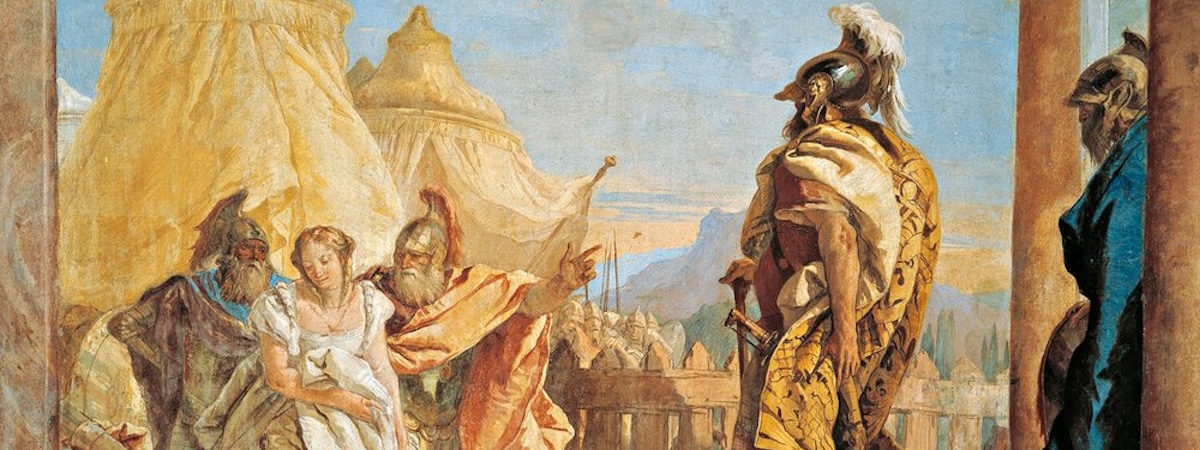
Finding Briseis: On Resurrecting a Forgotten Woman from Homer’s Iliad
Emily Hauser Explores Ancient Greek Visions of Gender
In the grand sweep of the Homeric Iliad, as the narrative careers along the course set by these blustering heroes and kings with their easily offended pride and buffed-up honor, it’s been easy in the past to lose sight of Briseis—the enslaved woman and victim who actually started it all. Here is a woman traded back and forth between the Greeks, her body the property of men, who crops up throughout the poem mostly in painfully offhand cameos of rape: “Achilles slept inside the well-built hut, and with him lay the beautiful Briseis.”
In spite of the fact that she’s the reason the entire plot of the epic exists, she’s given only a few lines of dialogue, towards the end of the poem: about the same amount of speaking time as Achilles’ magical male talking horse (yes, he has a talking horse), who erupts into speech just after Briseis’ only lines in the epic. A blistering example of upstaging.
But, looking for Homer’s women—and when I was writing For the Most Beautiful—I’ve been fascinated by the possibility of mining the Homeric text for all the details it can tell us about Briseis in particular. My idea was to see if there was a way we could bring this character who lay hidden at the heart of the Iliad—captured into slavery, raped by the man who killed her family, traded back and forth between men—back into the foreground.
Searching through an obscure passage in the second book of the Iliad, in which Homer details all the Greek ships—the “thousand ships” launched by Helen—that came to Troy, I unearthed an often neglected passage that tells us more about this long-overlooked character. She was, Homer tells us, taken captive by Achilles when the Greeks razed the town of Lyrnessus, on a campaign of terror around the Troad (the area around Troy) that also saw the devastation of another city, Thebe.
Achilles later boasts of the destruction of Lyrnessus himself. “I ravaged it,” he says, “and took away the women as captive slaves [lēiades ], robbing them of their day of freedom.”
My idea was to see if there was a way we could bring this character who lay hidden at the heart of the Iliad—captured into slavery, raped by the man who killed her family, traded back and forth between men—back into the foreground.
These parallel war raids by the Greeks—smaller attacks on neighboring cities to accompany the larger siege on Troy—crop up throughout Homer, both in the Iliad and the Odyssey: they’re clearly seen as a singularly calculating necessity to feed, equip and, above all, reward a marauding army in the Homeric economy (particularly in the long nine years that precede the tenth year of the war, in which the Iliad opens).
And among the most highly prized of the possessions taken in these raids—clearly, as Agamemnon and Achilles’ reactions show when they’re faced with losing them—are the women. With their men slaughtered, local women in the epic like Briseis are driven to a horrific existence, enslaved by their Greek captors and the killers of their fathers, husbands and brothers—utterly powerless victims of war, subject to the soldiers’ every whim, including rape.
And yet the Iliad, with its focus on men and men’s power, tells us very little about how it feels to be a woman in war, enslaved, raped, trafficked: Homer gives us just one brief glimpse of the horror of Briseis’ loss of freedom as she’s shuttled from one rapist slaveowner to another—”unwillingly,” the poet says. How much oppression, of how many women, lies behind that one word.
The reference to the town of Thebe in Briseis’ story isn’t incidental. It connects her to another woman, Andromache, wife of the Trojan prince Hector. Andromache, we’re told, came from Thebe, the same town that Achilles and the Greeks destroyed when they laid waste to Briseis’ Lyrnessus.
When Hector visits Andromache in Troy in the sixth book of the Iliad, she begs him to think of the consequences of war on women, reminding him that she’s lost everything in the raid that—in the early years of the war around Troy—devastated her home. Similarly to Briseis, Achilles slaughtered her father and her seven brothers, she says; he enslaved her mother before freeing her for ransom.
But Hector isn’t entirely blind to the outcomes of war. He knows only too well, he says, that there will come a time when Troy will fall. And when that happens, he predicts Andromache’s future: dragged away by a bronze-clad Greek warrior, she will be shipped to Greece as a slave, set to carry water or to weave at the loom at some other woman’s bidding. What he fails to mention is the fact that she will also certainly be raped.
Another vision of what happens to women after the Trojan War appears in the epic that follows its fall, the Odyssey. Odysseus, voyaging on his way home from Troy and leaving the smoking ruins of the city in his wake, hears a bard singing the tale of Troy’s fall.
The legend has clearly already made its way to far-away lands. He hears the poet tell the tale of the Trojan Horse that Odysseus invented, how the Greek warriors poured from inside the horse and “sacked the city; how they scattered out, destroying every neighborhood.” Odysseus, upon hearing the tale, melts into tears, and “his cheeks were wet with weeping, as a woman weeps”:
as she falls to wrap her arms around
her husband, fallen fighting for his home
and children. She is watching as he gasps
and dies. She shrieks, a clear high wail, collapsing
upon his corpse. The men are right behind.
They hit her shoulders with their spears and lead her
to slavery, hard labor, and a life
of pain. Her face is marked with her despair.
It is an extraordinary, shattering simile. At the moment where the poet (very much on the pattern of Homer) memorializes the Greeks’ victory at Troy, at the moment where Odysseus might be presented as the triumphant conqueror and respond with pride to his role as the daring strategist, the narrative is sliced open by the disruptive power of women’s grief; testifying to their terrible experiences, behind and beyond men’s acts, of the devastation of war.
Clearly, there is a pattern being established here. The Homeric battle campaign at Troy sets up an inevitable paradigm: women, not only from the city of Troy but from all its surrounding towns, are being rounded up and hauled back to Greece as war prizes.
The economy of the Iliad—and the epic makes this clear from the very start, with the opening quarrel over Briseis and Chryseis—rests on the conversion of raped and enslaved women into men’s glory, through the accumulation of enslaved women as war trophies that attest to a man’s prowess. This is the reason, plain and simple, why Agamemnon and Achilles get so angry at the start of the Iliad.
Achilles’ wrath—his programmatic mēnis that drives the poem forward—is the pique of a man whose trafficked woman has been taken from him and so has reduced the aggregate of his honor. The gleaming epic of heroes like Achilles is, when you flip the coin to its grittier side, powered by the oppression of women.
But, at the same time, this is a bigger story than the acts of violence perpetrated against women in one war. The capture and rape of the women of Troy is explicitly justified, by Homer’s Greeks, as repayment for Paris’ original seizure of Helen.
Nestor, one of the Greek leaders, tells the Greeks with brutal calculation that nobody should sail back home “before he shares a Trojan woman’s bed to pay for Helen’s sufferings and struggles.” In other words, this is a war that started because one man sexually assaulted and captured one Greek woman, Helen; but this has become a war that is entirely about possessing, and raping, as many non-Greek women as possible.
The framework of the legend of Troy rests on, and is brought to completion by, the rape of women. Whether or not Helen might actually have gone of her own accord with Paris is a moot point, in the eyes of the Greek men. It’s all about the rhetoric of payback, commodification, and rape in revenge.
Achilles says as much, hurling back his insults to Agamemnon: “Why should the Greeks make war against the Trojans? Was it not to retrieve a woman, Helen?” All of which explains why, in this war that is waged by men to capture women, the epic begins with Briseis: one victim among many, rounded up in the Greek camp, when the Greeks came to Troy.
One raped and trafficked woman, enslaved to boost men’s egos, converted into currency to bolster their glory, and scapegoated as reparation for Helen’s loss. And Andromache, when Troy falls, when boatloads of enslaved women are shipped back to Greece, will be one of the many to come.
Which brings us back to the (historical) Pylos tablet, and the Chian women. Although they’re never specifically called slaves, there are clues within the tablets that these women are—like Briseis, like Andromache—exactly those kinds of enslaved foreign victims, deported back to Greece, that Homer mentions.
First and foremost is their eastern Aegean provenance, linking them with Troy, not far away from Chios on the east Aegean seaboard, and the growing (historically attested) expansionism of the Mycenaean Greeks into the east. And the Chian women aren’t alone: other tablets found in the archive room in the palace at Pylos list groups of women workers from other areas nearby in the eastern Aegean—Miletus, Knidos, Halicarnassus, Lydia (all in modern-day western Turkey) and Lemnos (an Aegean island).
We even find one enslaved woman listed on the Pylos tablets who—incredibly—seems to come from Troy itself: to-ro-ja, or Trōia—a real-life Trojan woman.
All these groups of women are united by several distinct characteristics, aside from their eastern-Aegean ethnicity. They are assigned to low-status, labour-intensive and back-breakingly repetitive tasks: flour- grinding, wool-carding, linen-working, and so on.
They are treated as an undifferentiated mass, without any individual identity: none of these women are given a name, apart from their ethnicity (other, higher-status women do get names in the tablets: Kessandra, Karpathia and Philopatra are just a few examples). They are totally dependent on the palace for their survival, through the food rations apportioned to them.
They are separated from the men (these tasks are for women only); their children are co-opted into labor too, with the boys taken away from their mothers to labour in the fields as soon as they reach maturity.
Briseis and Chryseis, Homer’s two enslaved women whose trafficking sets the stage for the drama of the Iliad to begin—are inseparable in Homer.
Finally, at one point in the tablets, they’re listed alongside a cluster of Linear B symbols that, when sounded out, gives us a single word: ra-wi-ja-ja (or lawiaiai ). Astonishingly, this word seems very likely to be the Linear B, older Greek version of exactly that same term which Homer’s Achilles uses to boast about his capture of Briseis and the women of Lyrnessus: lēiades—captive women slaves.
In other words, it’s highly likely that these real, historical women from the eastern Aegean (and their children), recorded in the tablets at Pylos and set to work at the loom, were taken captive in war, deported to Greece and coerced into labor there as enslaved women. Just like Briseis and Andromache in Homer.
It’s a shudderingly, almost disturbingly real testament to the actual experience of women like Briseis: captured on the east Aegean coast by the Greeks, forced to work for their economy as enslaved women, trafficked to Greece to live on rations and break their bones with weaving—never seeing their homes again.
*
Briseis has found a new place in women’s writing in recent years, but it’s not the first time she has cropped up in literary retellings. Even in the ancient world, a flurry of fan fiction retold the Trojan War story—from a fake diary purporting to be written by a Trojan soldier called Dares the Phrygian (a late Latin translation of a Greek forgery), to a pretend “official history’=” of the Trojan War by a Greek commentator.
Dares, in his account, calls Briseis “Briseida”—a name that reappears in later medieval romances on the Trojan War that used Dares as their sourcebook, such as the French poet Benoît de Sainte-Maure’s hugely successful twelfth- century Romance of Troy.
But it is here that something interesting happens. Because, as the texts and accounts filter down through the literary tradition, Briseis—or Briseida—starts to fuse with another Homeric woman: Chryseis, enslaved by Agamemnon, and Briseis’ counterpart in the Greek leaders’ quarrel. (It’s the loss of Chryseis—when her father, a Trojan priest, delivers an impassioned speech to Agamemnon and prays to Apollo to bring a plague on the Greeks to get his daughter back—that makes the Greek king turn to Briseis, Achilles’ prize, instead.)
For Benoît de Sainte-Maure, Briseida is now a priest’s daughter, like Homer’s Chryseis, embroiled in a courtly love triangle between a young Trojan prince, Troilus, and a Greek warrior, Diomedes. By the time this much-adapted story reaches medieval England (via the Italian poet Boccaccio) in the late fourteenth century, Briseida has become Criseida and then (in an epic of Chaucer’s) Criseyde—cementing the fusion between the two Homeric women.
And it’s only a matter of time before Shakespeare picks it up and delivers it on to the stage at the Globe Theatre in London, with his Troilus and Cressida, probably performed in around 1603.
Briseis and Chryseis, Homer’s two enslaved women whose trafficking sets the stage for the drama of the Iliad to begin—are inseparable in Homer. Their story goes together: two women who are both totally powerless and, at the same time, lie at the crux of the narrative—and the intertwining of their stories stays that way for much of their literary afterlife.
But, in many ways, Chryseis—in spite of the apparent privileging of her name and her identity as a priest’s daughter that makes its way into the later stories about her—is the more silent, the more difficult to bring back to life, of the two. Once her father succeeds in recovering her, she is shipped back home halfway through the first book of the Iliad, never to be heard of again; in contrast to Briseis, whom Homer allows to speak once (in her lament for the death of Achilles’ partner Patroclus), Chryseis doesn’t say a single word.
Her role, it seems, is to be drowned out by her father’s voice in the drama of his determination to set her free, and his brazen run-in with a king; to be cast in his shadow as a sheltered young girl, and silent daughter. So how do we go about finding Chryseis—the girl who never speaks?
______________________________

Reprinted with permission from Penelope’s Bones: A New History of Homer’s World through the Women Written Out of It by Emily Hauser, published by the University of Chicago Press. © 2025. All rights reserved. This book is published in the UK as Mythica: A New History of Homer’s World, Through the Women Written Out of It by Penguin Books.
Emily Hauser
Emily Hauser is a senior lecturer in classics and ancient history at the University of Exeter, UK. She is the author of three novels reimagining the women of Greek myth: For the Most Beautiful, For the Winner, and For the Immortal. She is also the author of How Women Became Poets and Penelope's Bones.












